
A SHORT STORY ABOUT DRUMS, MIKING AND OTHER THINGS
OK, Not Really a Short Story…
Throughout time, most drummers have always looked for ways to make their drums sound better. Over the years one of the main issues they’ve had concerned their resonant heads. Back in the late 60’s and early 70’s the advent of those monster amplifiers forced many drummers to remove the resonant heads just to compete volume wise with the rest of the band. This spawned the creation of the Concert Toms, that were built with only batter heads. Still, the toms especially always seemed to suffer.
As PA systems evolved, they eventually allowed the drums to be included in the mix. Since most bands found it now practical to mic the drums, eventually the heads went back on. Another reason is that guys were once again more interested in the quality of the sound and feel – and not the volume. Kick drums also went back to having resonant heads – the only thing changing was the hardware sold throughout the years.
Miking has also changed along with drummers in regards to the resonant heads. Standard drum miking is typically done from the batter head for all drums EXCEPT the kick drum (which strikes me as odd) When guys started removing the resonant heads, sound engineers started sticking mics up inside the drums, which worked well for two reasons. The mics were better isolated and shielded from the cymbals and other drums and also away from the players where they couldn’t be hit.
So once upon a time, I started to think about drums and speakers in cabinets and how the two were quite similar. Both are specifically designed wooden enclosures that determine the overall sound and both produce that sound primarily at the heads. I also thought about the speaker and the resonant head sharing the same responsibility of transmitting the sound (albeit by different methods) from the front of the enclosure. In this instance the resonant head IS the speaker and if so, why not make it a speaker? Then it could be miked like a normal speaker enclosure where a variety of attack and tone could be achieved by placement of the microphone either on-axis or off-axis along the cone.
I also thought if ALL the drums shared this same principal, then ALL the drums should be miked the same way. What also seemed logical was that placing microphones underneath, away from the player would eliminate popping noises and mic damage from drum stick hits while greatly improving isolation.
The Toms benefit the most from this. First, the tone and “feel” of the drum is just like having the regular resonant head on. But, like having the head off, there’s also a slight increase in volume, since the speaker cone directs the sound which is big and beefy. With cymbal bleed-through is gone, the full tone comes through and mic placement issues are eliminated.
For all the drums, head tension plays a major role in the overall tonal range of the drum, as evident when the heads are correctly tuned. The resonant heads’ tension controls the amount of ring and resonance in concert with the batter head but also plays a part in the response or “feel” of the drum. A normal music speakers’ tension is fixed, but in using a pliable outer gasket, the tension can be varied and depending on this tension on what’s called the surround, the lower overtones can be controlled, as the excursion of the cone is limited by the stiffness of the gasket based on tension.
This is the story behind the creation of the SpeakerHeads®, not only a product, but a concept.




